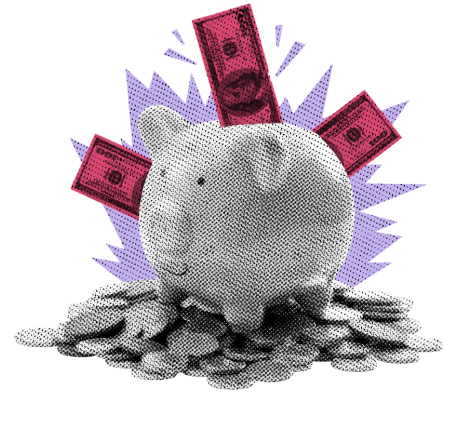
Stocks rallied yesterday with solid economic numbers, supported by sweet-talk from the Fed. GDP growth estimates were revised upward fueling hopes of a soft landing.
Point of view. Have you heard? Inflation is ebbing. It’s still higher than it should be, AND we are still paying a lot more for things than we were just a few years ago. But it was high inflation that turned the Fed from benevolent leader to ruthless oppressor of our stock and bond portfolios. The Fed didn’t just tighten monetary policy it literally wrang the neck of the US economy with a stream of monster rate hikes and quantitative tightening. It didn’t happen overnight, but the hikes did their job causing an economic slowdown and a decline in inflation. It bears noting that there were other factors that caused inflation to decline.
The economy has a lot of built-in mechanisms to keep itself in line. Without too much interruption the economy, inflation, and everything else would behave cyclically, self-healing wounds. This happens because firms, and yes, people are rational, and they ultimately respond to events, creating wrongs, but also, ultimately righting them. This concept has been well understood and dates back to Adam Smith’s seminal 1776 work The Wealth of Nations. Now as a modern society, we don’t have lots of patience, expecting instant results. We have no time for the great economic clearing engine to work its natural magic. Central banks are the answer. If things are going too slowly, they simply give the economy a push, and if they are going too quickly, they slow things down. Sounds so simple, doesn’t it? But economies are big beasts, and they don’t yield so easily, or as quickly as we would like. This causes central bankers to, sometimes… er, most times, overshoot.
Just think about what happened in the last few years. It was a disruption in the supply chain that initially caused inflation to pick up. The disruption was caused by a rare, but natural event. That same event caused lockdowns leaving consumers with little option other than to spend money. The Government, not the Fed in this case, decided to speed things up by providing stimulus money to consumers. And it certainly worked! Consumers went out and spent it… with flair. Less goods and more dollars chasing them is a classic recipe for INFLATION. Oh, and the central bank opened the flood gates simultaneously. Inflation came, sure as the seasons themselves. With no time to let things right themselves the central bank jumped in and slammed on the brakes. This made borrowing more expensive, which made life challenging for any company or person who… borrowed. This would theoretically slow demand and inflation. The rate hikes also served to literally erase wealth accumulated in stock and bond portfolios. That also served to weaken sentiment and lower demand. If all that worked just perfectly, the Fed would take its foot off the brakes at some point and let the economy return to using its own power. We are at that junction now.
Before I move on, I want to point out the supply problems, which were the principal cause of inflation, ultimately righted themselves. The Fed’s draconian cuts had NOTHING to do with it. Some may even argue that consumers pulled back on spending, NOT BECAUSE OF HIGH INTEREST RATES, but because prices were too high. Would you agree? This is basic supply and demand, as thoroughly explored in Alfred Marshall’s 1980 work Principals of Economics, which built upon Smith’s earlier work. Did I just digress? Sure, I did.
I digressed because I wanted to remind you of the emotional, mental, and financial journey we have been on together for these past several years. Whew! And a journey it certainly was. As part of that voyage, investors and, I WILL CONCEDE, even consumers spent the better part of the past two years yearning for one thing, and one thing only: rate cuts. Let’s not get into why, but I know that you too are guilty of adding rate cuts to your evening prayers. We knew that the Fed would cut rates for only two principal reasons 1) inflation got down to +2% or 2) the economy became ill. Reason number 2 would trump reason number 1, so then, naturally, an ill economy became a path to salvation. Every bad economic number would get us closer to rate cuts and therefore, became wind in the sails of the stock market. BAD for the economy was GOOD for stocks. Doesn’t it seem so silly when you read it? But it was Wall Street’s basic strategy since rates peaked in Summer 2023.
Inflation has pulled back and seems like it is firmly on the path to the Fed’s self-created target. The economy has cooled down but is still firmly chugging along. The demure Fed is mindfully, and low key, taking a victory lap and has decided to let up on the brakes. But folks, we are clearly not out of the woods. While the economy is chugging along, there are some hints that some of the Fed’s tormenting of years past has yet to take effect. Unemployment is ticking higher, consumption is slowing, and consumer sentiment has not recovered to pre-rate-cut levels. That means that a recession with a massive unemployment spike is still a possibility. The Fed thinks so too.
Though they haven’t said it, their -50 basis-point cut when most economists were expecting only -25 was a clear sign of the Fed’s concern. This marks a sea change in how we need to look at economic releases going forward. Stocks have a bullish feel to them and, indeed, stocks, for the most part tend to rally in the wake of rate-policy shifts. However, there are still many would-be, rally saboteurs lurking in the shadows. Sure, inflation could pick up again, as it did in the 1980s, but the chief potential stumbling blocks are economic recession and a corporate earnings growth recession. What I want you to walk away from today’s note is that in this new regime, BAD for the economy is BAD for stocks and slowing earnings growth cannot be ignored. But don’t get all hot and bothered, we have the Fed on our side, and it seems to be willing to help speed things along if our already threadbare patience wears thin.
YESTERDAY’S MARKETS

NEXT UP
- Personal Income (August) is expected to have grown by +0.4% after climbing by +0.3% in July.
- Personal Spending (August) is expected to come in at +0.3% down from the prior period’s +0.5% reading.
- PCE Deflator (August) may have slowed to +2.3% from +2.5%.
- University of Michigan Sentiment (September) may be revised up to 69.4 from 69.0.
- Next week: earnings will start to pick up leading to the following week’s start of earnings season. Additionally, we will get JOLTS Job Openings, ISM PMIs, Factory Orders, and the monthly employment situation. If you paid attention up top, you would know that at least 2 of those releases have the potential to move the markets meaningfully, so check back in on Monday to download the weekly economics and earnings calendars.
.png)

